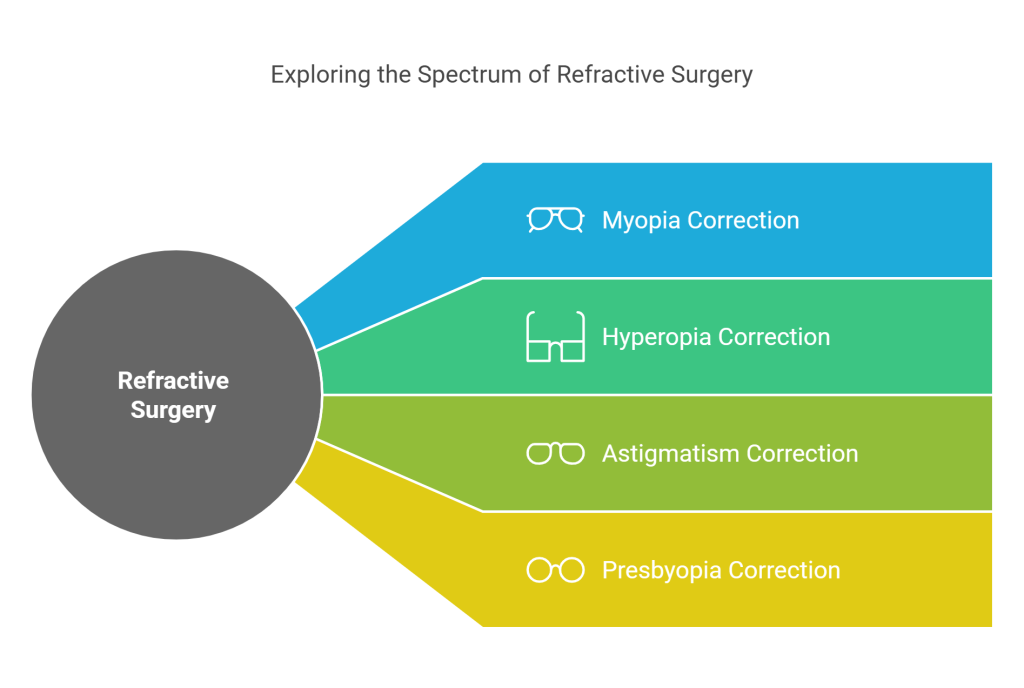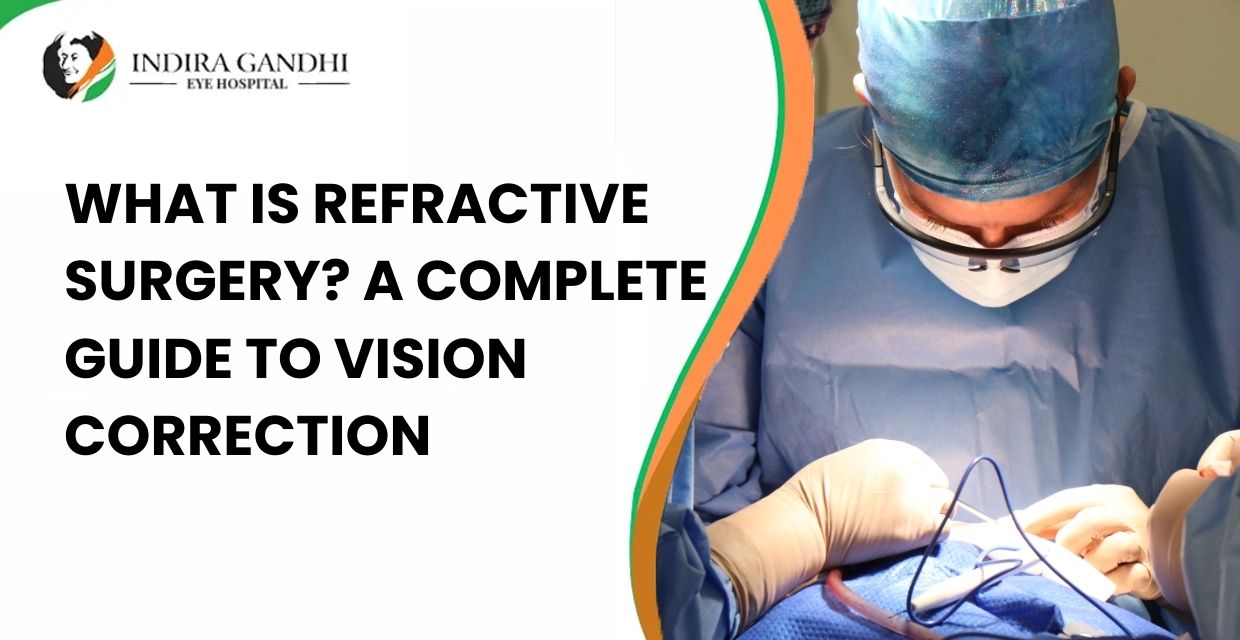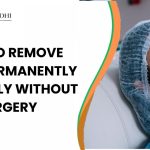|
Getting your Trinity Audio player ready...
|
Vision correction has seen remarkable advancements over the years, and refractive surgery stands out as a revolutionary solution for individuals seeking freedom from glasses or contact lenses. But What Is Refractive Surgery? In this comprehensive guide, we will explore the fundamentals of refractive surgery, its various types, who it’s suitable for, and how it can transform your vision.
Understanding Refractive Surgery

Refractive surgery refers to a collection of surgical procedures designed to correct common vision problems, such as myopia (nearsightedness), hyperopia (farsightedness), astigmatism, and presbyopia (age-related loss of near vision). The primary goal of refractive surgery is to reshape the cornea or lens to improve the way light rays are focused onto the retina, leading to clearer vision.
This transformative procedure can significantly reduce or even eliminate the need for glasses or contact lenses, providing individuals with a new level of convenience and confidence. With advanced technology and expert surgeons, refractive surgery has become a safe and highly effective option for millions worldwide.
How Does Refractive Surgery Work?
Refractive surgery works by altering the curvature of the cornea, which is the clear, dome-shaped front surface of the eye. In some cases, the procedure involves replacing or modifying the lens inside the eye. By making these adjustments, refractive surgery corrects the way light enters the eye and focuses on the retina, the light-sensitive layer at the back of the eye.
The exact method used depends on the specific type of refractive error and the procedure chosen. Below, we’ll discuss the most common types of refractive surgeries and their respective mechanisms.
Types of Refractive Surgery
There are several types of refractive surgery, each tailored to address specific vision issues and patient needs. LASIK (Laser-Assisted In Situ Keratomileusis) is one of the most popular procedures. It involves creating a thin flap on the cornea, lifting it, and using a laser to reshape the underlying tissue. Patients often experience rapid recovery and improved vision within 24 hours. Another option is PRK (Photorefractive Keratectomy), which removes the cornea’s outer layer to reshape it with a laser. This procedure is ideal for those with thin corneas, although it requires a slightly longer recovery period.
SMILE (Small Incision Lenticule Extraction) is a minimally invasive procedure where a laser creates and removes a thin disc of tissue within the cornea. It’s known for precision and reduced risk of dry eye syndrome. For older patients or those with severe refractive errors, RLE (Refractive Lens Exchange) replaces the eye’s natural lens with an artificial intraocular lens. Implantable Contact Lenses (ICL) provide an alternative for individuals with extreme refractive errors, inserting a custom lens inside the eye without reshaping the cornea.
Benefits of Refractive Surgery
Refractive surgery offers numerous advantages, making it a life-changing option for individuals with vision problems. Most patients achieve 20/20 vision or better, significantly improving their quality of life. By eliminating the need for glasses and contact lenses, refractive surgery provides unparalleled convenience. Recovery times are often quick, with many individuals resuming normal activities within a day or two. Additionally, the results are typically long-lasting, requiring minimal adjustments over time. Improved vision boosts self-esteem and confidence, especially in social and professional settings, making refractive surgery an attractive choice for many.
Who Is a Good Candidate for Refractive Surgery?
While refractive surgery is a safe and effective option for many, it’s not suitable for everyone. Ideal candidates are generally at least 18 years old with a stable prescription for at least one year. Good eye health is crucial, meaning no active infections, injuries, or severe dry eye syndrome should be present. Candidates should have a stable refractive error that hasn’t changed significantly in the past year. Additionally, sufficient corneal thickness is necessary for procedures like LASIK and PRK to ensure safety. Finally, having realistic expectations about the procedure’s outcomes is vital for a positive experience. Individuals who meet these criteria and consult a specialist will better understand if refractive surgery is right for them.
Risks and Complications
As with any surgical procedure, refractive surgery carries some risks, but they are generally rare and manageable. Temporary dry eyes are common and can be treated with artificial tears. Some patients may experience glare or halos around lights, particularly at night, though these effects typically diminish over time. In rare instances, undercorrection or overcorrection may occur, requiring additional surgery for optimal results. There is also a minimal risk of infection, which can be prevented with proper post-operative care. Regression, or a gradual return of refractive error, is uncommon but possible. Discussing potential risks with a surgeon ensures informed decision-making and sets realistic expectations.
Post-Operative Care
Proper post-operative care is essential for a smooth recovery and optimal results. Patients are advised to avoid rubbing their eyes for the first few weeks to prevent complications. Prescribed eye drops help prevent infection and reduce inflammation. Wearing sunglasses protects the eyes from bright light and UV exposure during the healing period. Follow-up appointments allow the surgeon to monitor progress and address any concerns promptly. Activities like swimming and using hot tubs should be avoided in the initial recovery phase. By adhering to these guidelines, patients can enjoy the full benefits of refractive surgery with minimal risk.
For patients considering vision correction, explore Refractive Eye Surgery in Gurgaon to discover state-of-the-art treatments and expert care.
Advances in Refractive Surgery Technology
Technological advancements have significantly improved the safety and precision of refractive surgery. Modern lasers offer unparalleled accuracy, while wavefront-guided LASIK customizes treatments to the unique characteristics of each eye. Innovations such as SMILE and ICL provide more options for individuals with specific needs, such as thin corneas or high prescriptions. These advancements ensure that refractive surgery continues to evolve, offering better outcomes and patient satisfaction. By addressing a wide range of vision problems, these technologies make refractive surgery accessible to more individuals than ever before.
Myths About Refractive Surgery
There are several misconceptions about refractive surgery that may deter individuals from pursuing this life-changing procedure. Contrary to popular belief, refractive surgery is virtually painless due to the use of numbing eye drops during the procedure. While younger individuals are common candidates, older adults with healthy eyes can also benefit. Recovery times are typically short, with most patients resuming normal activities within a few days. Additionally, the results of refractive surgery are long-lasting for the majority of patients, providing years of improved vision without the need for corrective eyewear. Addressing these myths helps individuals make informed decisions about their vision care.
Conclusion
So, What Is Refractive Surgery? It’s a collection of innovative procedures designed to correct vision problems and provide a life free from glasses or contact lenses. With advancements in technology and experienced surgeons, refractive surgery is safer and more effective than ever before.
If you’re considering refractive surgery, consult with a trusted eye specialist to determine the best option for your needs. At Indira Gandhi Eye Hospital, we offer cutting-edge refractive surgery procedures tailored to your vision goals. Take the first step toward clearer vision and enhanced quality of life today.
By understanding the procedures, benefits, and potential risks, you can make an informed decision and enjoy the transformative power of refractive surgery. Whether it’s LASIK, SMILE, or another advanced technique, the journey to better vision has never been more accessible.












